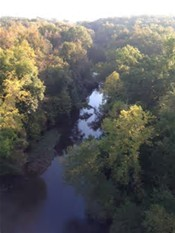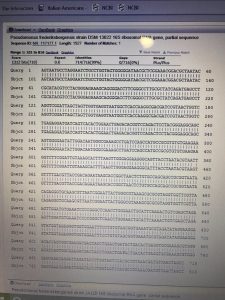Pseudomonas frederiksbergensis is a Gram-negative bacteria. It was discovered by from a coal gasification site in Frederiksberg, Copenhagen, Denmark. This bacteria was cultured by Andersen S, Johnsen K, Sorensen J, Nielsen P, Jacobsen C. in 2000.
References:
- Andersen S, Johnsen K, Sorensen J, Nielsen P, Jacobsen C. 2000. Pseudomonas fredricksbergensis sp. nov., isolated from soil at a coal gasification site. Int. J. of Syst. and Evol. Microbiol. 50:1957-1964.
Date collected: February 8, 2017
Methods for isolation and identification:
- Soil was taken from the Appomattox River (Figure 1), diluted by 1:10, then placed on an agar plate and isolated at room temperature for 48 hours
- A purple colony was taken from the plate for DNA isolation and PCR amplification
- When the PCR product was produced, it was digested with MSP1 and run through a gel
- Once the PCR was done and the DNA was purified it was sent of for sequencing so we could determine what bacteria it was
 Figure 1: Collection site at the Appomattox River
Figure 1: Collection site at the Appomattox RiverResults:
- The sequenced PCR product for the 16s rRNA gene generated 714 bases that were used to identify the genus and species of the bacteria colony. NCBI BLAST analysis revealed 99% identity with the bases of the 16s rRNA gene of Pseudomonas Fredricksbergenesis. There was found to be no gaps and 714 out of 716 base pairs were matched. Below shows the Blast percentages (Figure 2). Figure 3 shows the base pairs. Attatched is a more clear visual of the Blast sequence: http://blogs.longwood.edu/pecmicrobes/files/2017/04/Sequenced-dna.pdf
| Score | Expect | Identities | Gaps | Strand | Frame |
| 1312 bits(710) | 0.0() | 714/716(99%) | 0/716(0%) | Plus/Plus |
Figure 2: Blast data

Figure 3: The blast base pairs
Contributed by: Alyssa Oppedisano, Elle Richardson, Murriel Grimes BIOL 250 – Spring 2017, Longwood University